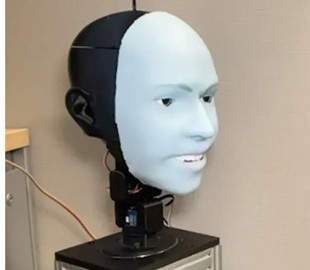Technology allows androids to smoothly change facial expressions


Scientists from Osaka University have developed an innovative technology that allows androids to create realistic facial reactions using a “wave motion” model that mimics the natural dynamics of the human face.
This method is based on the principle of wave propagation, resembling fading oscillations that encompass actions such as blinking, breathing, or yawning. The waves interact with related areas of the face, overlapping each other to form complex facial expressions. Thus, the system eliminates the need for pre-setting complex scenarios and makes the transition between emotions smooth, avoiding the unnaturalness that could previously cause negative reactions in viewers.
The technology also includes wave modulation, which allows androids to instantly reflect changes in mood or “internal states”, such as excitement or sleepiness, by adapting facial expressions to the specific situation. According to Koichi Osuka, senior author of the study, this not only improves the emotional interaction between humans and robots, but also creates a sense of deep humanity in the interaction.
One of the key advantages of the new method — simplifying programming. In the past, creating realistic facial expressions required complex scripts and large amounts of data to pre-tune. The modern approach not only reduces these costs, but also makes robots more adaptive and cost-effective.
Hisashi Ishihara, one of the authors of the development, emphasized that the goal of the team is to create robots capable of showing emotions in detail, which can change the perception of androids by people. He noted that their further research may lead to the creation of robots that will be perceived as “emotionally alive”.
At this stage, the technology has already been successfully implemented in works with a high level of facial detail, which allows them to be used in areas where emotional connection with people is critically important: in education, medicine and the service sector. This opens up new horizons for the integration of androids into everyday life, making them more acceptable to society.
Recent Posts
In Germany, a shock drone for Ukraine was created: what can it be
< img src = "/uploads/blogs/19/46/ib-frts653ei_573d7391.jpg" Alt = "in Germany created a shock drone for Ukraine:…
Airbus postponed the release of a hydrogen aircraft by mid-2040s: reasons
< img src = "/uploads/blogs/40/4e/ib-frtsio7tr_a499ea2a.jpg" Alt = "Airbus postponed the release < P > The…
GTA 6 will be a very big game: how much space will you need to install it
< IMG SRC = "/Uploads/Blogs/00/44/IB-FRTP8SKUT_A2A6BBB1C.jpg" Alt = "GTA 6 will be a very big game:…
Google will restrict apps that deplete your smartphone battery
< IMG SRC = "/Uploads/Blogs/6F/CA/IB-1IPC456A8_2A6BBB1CB.jpg" Alt = "Google will limit the applications that exhaust the…
Firefighters do not hide their indignation. The priest refused to accept communion. The reason is surprising
The parish in Tarnawa Górna became loud. Everything after the priest refused the communion to…
Tradition has been fulfilled. Fans of the “Farmer looking for a wife” program do not hide their joy. They met the heroes of the next season
Who we will see in the new edition of the "Farmer is looking for a…